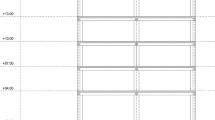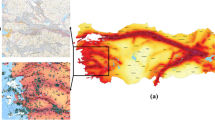Abstract
Shear walls, which are vertical elements with significantly high stiffness values, are becoming more and more popular and are widely used as primary lateral-load-resisting systems for reinforced-concrete (RC) buildings of various heights to ensure satisfactory performance. This study is thus devoted to assessing the performance of RC buildings with shear walls of different locations and configurations under the effect of seven different earthquake motions representing near‐source records. The buildings were designed to fit regions of medium seismicity following the ASCE 7–10 design requirements. Finite-element models were developed with shear walls, distributed over either the outer panel, the intermediate panel, or the center of the building. The seismic assessment of the developed building models was performed using dynamic nonlinear time–history analysis employing the selected full set of records. The results from the analysis clarified that the configuration and location of shear walls tend to significantly affect the induced story seismic responses. More specifically, building models with central core system, Configuration 7, provide the highest seismic responses among all other building models with about 50% which may lead to cost-effective earthquake-resistant design. From base shear design point of view, the use of shear walls distributed as parallel pairs along either the peripheral or the intermediate panel, Configurations 3 and 6, are the advantageous where they substantially reduce base shear by at least 33.20% among all other configurations.












Similar content being viewed by others
References
Brencich A, Gnecco M (2012) Failure case studies in structural engineering courses and professional practice. Arab J Sci Eng 37(8):2113–2126. https://doi.org/10.1007/s13369-012-0292-4
Tuken A, Siddiqui NA (2013) Assessment of shear wall quantity in seismic-resistant design of reinforced concrete buildings. Arab J Sci Eng 38(10):2639–2648. https://doi.org/10.1007/s13369-012-0482-0
Wallace JW, Moehle JP (1992) Ductility and detailing requirements of bearing wall buildings. J Struct Eng 118(6):1625–1644. https://doi.org/10.1061/(ASCE)0733-9445(1992)118:6(1625)
Wallace JW (1994) Anew methodology for seismic design of reinforced concrete shear walls. J Struct Eng 120(3):863–884. https://doi.org/10.1061/(ASCE)0733-9445(1994)120:3(863)
Burak B, Comlekoglu HG (2013) Effect of shear wall area to floor area ratio on the seismic behavior of reinforced concrete buildings. J Struct Eng ASCE 139(11):1928–1937. https://doi.org/10.1061/(ASCE)ST.1943-541X.0000785
Aly N, Galal K (2020) Effect of ductile shear wall ratio and cross-section configuration on seismic behavior of reinforced concrete masonry shear wall buildings. J Struct Eng 146(4):04020020. https://doi.org/10.1061/(ASCE)ST.1943-541X.0002542
Soydas O (2009). Evaluation of shear wall indexes for reinforced concrete buildings. M.S. thesis, Middle East Technical Univ., Ankara, Turkey. http://etd.lib.metu.edu.tr/upload/3/12610380/index.pdf
Turkish earthquake code (TEC) (2007) Regulations on structures constructed in seismic regions. Ministry of Public Works and Settlement, Ankara
Cando MA, Hube MA, Parra PF, Artetad CA (2020) Effect of stiffness on the seismic performance of code-conforming reinforced concrete shear wall buildings. Eng Struct 219:1–14. https://doi.org/10.1016/j.engstruct.2020.110724
Afzali A, Mortezaei A, Kheyroddin A (2017) Seismic performance of high-rise RC shear wall buildings subjected to ground motions with various frequency contents. Civil Eng J 3(8):568–584. https://doi.org/10.28991/cej-2017-00000113
Farghaly AA (2016) Seismic assessment of slender high-rise buildings with different shear walls configurations. Adv Comput Des 1(3):221–234. https://doi.org/10.12989/acd.2016.1.3.221
Titiksh A, Bhatt G (2017) Optimum positioning of shear walls for minimizing the effects of lateral forces in multistory-buildings. Arch Civ Eng LXIII 1:151–162. https://doi.org/10.1515/ace-2017-0010
Harne VR (2014) Comparative study of strength of RC shear wall at different location on multi-storied residential building. Int J Civ Eng Res 5(4):391–440. https://doi.org/10.13140/RG.2.2.35613.51688
Ali J, Bhatti A, Khalid M, Waheed J, Zuberi S. (2015) A comparative Study to Analyze the Effectiveness of Shear Walls in Controlling Lateral Drift for Medium to High Rise Structures (10–25 Storeys). 2nd International Conference on Geological and Civil Engineering IPCBEE volume 80 Singapore.
Tarigan J, Manggala J, Sitorus T, Tarigan J, Manggala J, Sitorus T (2018) The effect of shear wall location in resisting earthquake. IOP Conf Ser: Mater Sci Eng 309:012077. https://doi.org/10.1088/1757-899X/309/1/012077
Jayalekshmi BR, Chinmayi HK (2016) Effect of soil stiffness on seismic response of reinforced concrete buildings with shear walls. Innov Infrastruct Solut 1:1–18. https://doi.org/10.1007/s41062-016-0004-0
Farhan MA, Bommisetty J (2019) Seismic analysis of multistoried RCC buildings regular and irregular in plan. Int J Eng Res Tech 08(11):115–121
Yousuf M, Shimpale PM (2013) Dynamic analysis of reinforced concrete building with plan irregularities. Int J Emerg Tech Adv Eng 3(9):110–116
Computers & structures. (2018). ETABS: Extended three-dimensional analysis of building systems, Version 9.0, Berkeley.
Daee B, Aghakouchak A (2012) Assessment of nonlinear static procedures for determination of target displacements in asymmetric buildings. Adv Struct Eng 15(8):1265–1278. https://doi.org/10.1260/1369-4332.15.8.1265
Uang CM (1990) Bertero V V (1990) Evaluation of seismic energy in structures. Earthq Eng Struc Dyn 19(1):77–90. https://doi.org/10.1002/eqe.4290190108
Mostafa A, Mahmoud S (2014) Damage assessment of adjacent buildings under earthquake loads. Eng Struct 61:153–165. https://doi.org/10.1016/j.engstruct.2014.01.004
Author information
Authors and Affiliations
Corresponding author
Rights and permissions
About this article
Cite this article
Mahmoud, S. In-Plane Shear-Wall Configuration Effects on the Seismic Performance of Symmetrical Multistory Reinforced-Concrete Buildings. Int J Civ Eng 19, 1195–1208 (2021). https://doi.org/10.1007/s40999-021-00634-8
Received:
Revised:
Accepted:
Published:
Issue Date:
DOI: https://doi.org/10.1007/s40999-021-00634-8




